Overview
This article delves into the performance and applications of deuterium lamps, underscoring their vital role in UV-Visible spectroscopy and various analytical processes. These lamps are not merely instruments; they are the backbone of accurate measurements in critical fields such as pharmaceutical analysis and environmental monitoring. By providing stable and reliable light sources, deuterium lamps ensure precision in data collection, supported by their advanced specifications. Their compatibility with a range of spectrophotometers further enhances their utility, making them indispensable in laboratory settings. As we explore the significance of these lamps, it becomes clear that investing in high-quality scientific instruments is essential for achieving reliable results.
Introduction
In the realm of analytical chemistry, the significance of dependable light sources is paramount, especially in UV-Visible spectroscopy. The JM Science deuterium lamp emerges as a meticulously engineered solution, crafted to deliver a stable and continuous light source that laboratories rely on for precise measurements. Its capability to minimize output fluctuations empowers researchers to trust the spectral data they acquire—a necessity in high-stakes sectors such as pharmaceuticals and environmental monitoring. As advancements in deuterium lamp technology continue to unfold, their role in enhancing analytical accuracy and efficiency becomes increasingly vital, paving the way for innovations that will define the future of scientific research.
JM Science Deuterium Lamp: Reliable Source for UV-Visible Spectroscopy
The JM Science deuterium lamp is meticulously engineered to provide a stable and continuous light source, which is vital for UV-Visible spectroscopy. This innovative design minimizes output variations, ensuring that research facilities can obtain consistent and dependable spectral data. Such reliability is particularly crucial in fields like pharmaceutical analysis, where precision is essential for accurate results, and environmental monitoring, where data integrity can significantly influence regulatory compliance. Moreover, the light source's compatibility with a diverse range of spectrophotometers enhances its versatility across various laboratory settings.
Recent advancements in hydrogen isotope lighting technology have further bolstered performance, establishing these sources as indispensable instruments in . Experts emphasize that stable light sources, such as the deuterium lamp, profoundly impact the reliability of spectral data, underscoring their importance in critical analyses. As pharmaceutical firms increasingly rely on UV-Visible spectroscopy for drug development and quality assurance, the significance of hydrogen isotope light sources becomes even more apparent, ensuring that researchers can trust their results.
Notably, the inclusion of heavy hydrogen can enhance the pharmacokinetic characteristics of compounds processed by cytochrome P450 enzymes, highlighting its importance in pharmaceutical applications. Tracey Pirali, an industry expert, points out that such investments have led to the development of the first deuterated drug, deutetrabenazine, which was approved by the FDA in 2017. This underscores the critical role stable light sources play in drug development.
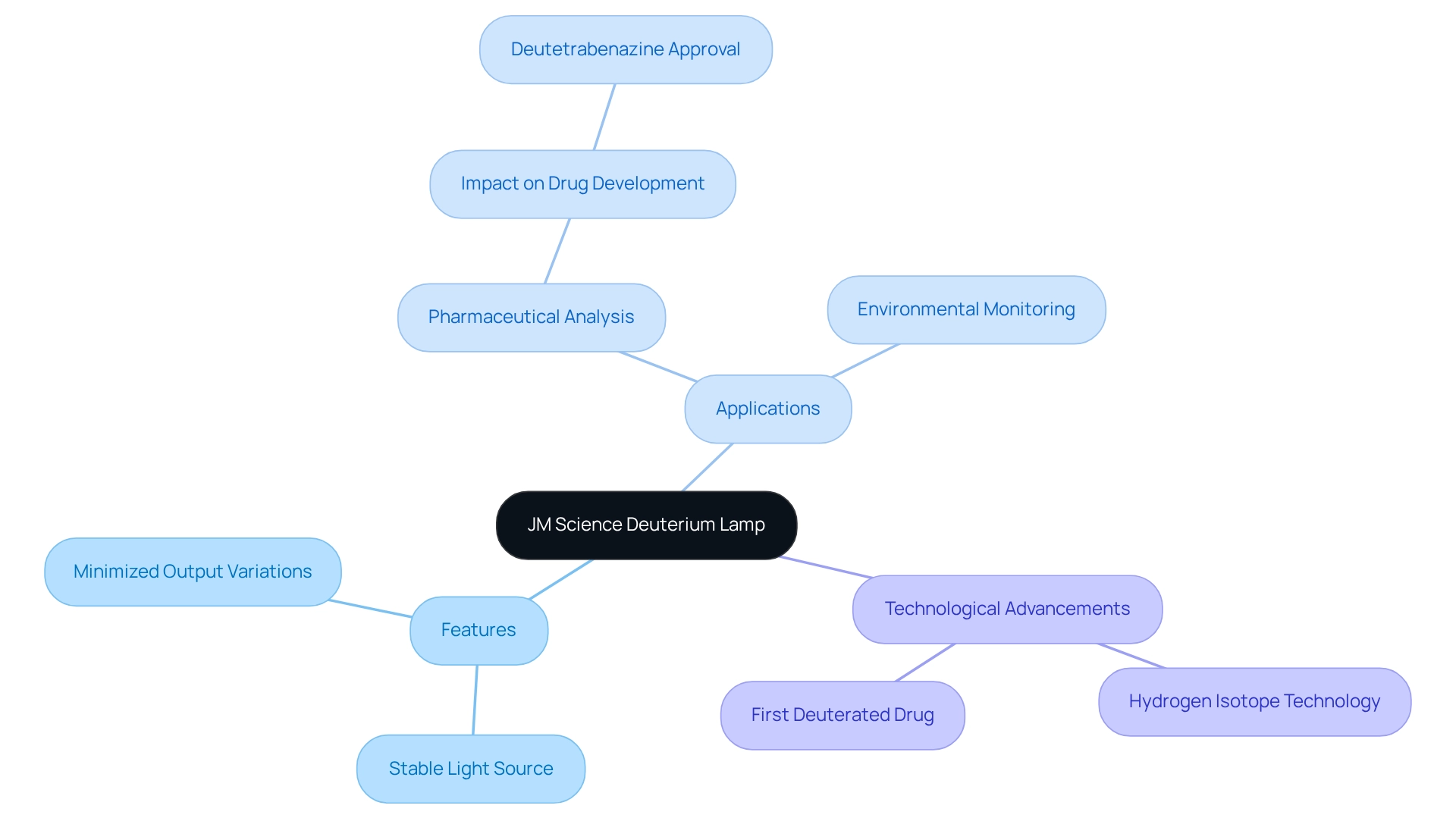
Deuterium Lamp Specifications: Key Features and Performance Metrics
The JM Science light source presents exceptional specifications, encompassing a wavelength range from 160 nm to 400 nm, vital for a variety of UV light applications. Engineered for high spectral output, these lamps ensure consistent intensity, which is crucial for accurate absorbance measurements in analytical chemistry. With a typical lifespan of approximately 2000 hours, and newer models exceeding 5000 hours, they stand out against other light sources that often exhibit shorter operational lifetimes. Notably, heavy hydrogen possesses a molecular bond strength of 439.5 kJ/mol, compared to 432 kJ/mol for light hydrogen, indicating superior stability and performance in various applications. Their compact design allows for seamless integration into existing research setups, providing ease of installation and space-saving advantages, thereby enhancing versatility across diverse analytical contexts.
In practical applications, play a pivotal role in HPLC detectors, emitting a UV spectrum that facilitates precise measurements. Constructed from synthetic quartz, these fixtures guarantee efficient UV radiation transmission, making them indispensable for facilities focused on high-performance liquid chromatography. Laboratories utilizing hydrogen isotopes, for instance, benefit from stable gas discharge, essential for maintaining measurement accuracy. As of 2025, JM Science remains committed to supplying deuterium lamp light sources that are compatible with leading manufacturers such as Agilent, PerkinElmer, Varian, and Waters, reinforcing their dedication to providing high-quality solutions tailored for the scientific community. The successful implementation of the deuterium lamp sources in HPLC applications further underscores their importance in achieving reliable analytical outcomes.
Deuterium Lamp Lifespan: Understanding Operational Longevity
Deuterium sources typically offer an operational longevity of approximately 2,000 hours, reflecting the standard lifespan of Agilent products; however, this can vary based on usage conditions. Key factors that influence their lifespan encompass the frequency of use, power settings, and environmental conditions within the laboratory.
To ensure optimal functioning and minimize downtime, consistent monitoring of the light source is essential, with recommendations to assess it at least every three months. Should testing indicate issues, it is vital to first optimize the detector; if problems persist, replacing may be necessary. Implementing a structured maintenance plan can significantly prolong the life of deuterium lamps.
Facilities that embrace proactive maintenance strategies, such as routine performance checks and timely replacements of equipment like the deuterium lamp, have reported increased reliability and efficiency in their analytical processes. A case study from JM Science Inc. demonstrates how a facility that adhered to a rigorous maintenance schedule experienced a 20% boost in operational efficiency, highlighting the tangible benefits of such practices.
By prioritizing maintenance, laboratories can maximize the utility of their isotopic light sources and uphold high standards in analytical applications. A comprehensive maintenance checklist includes:
- Testing the light source every three months
- Optimizing the detector as needed
- Scheduling replacements based on performance evaluations
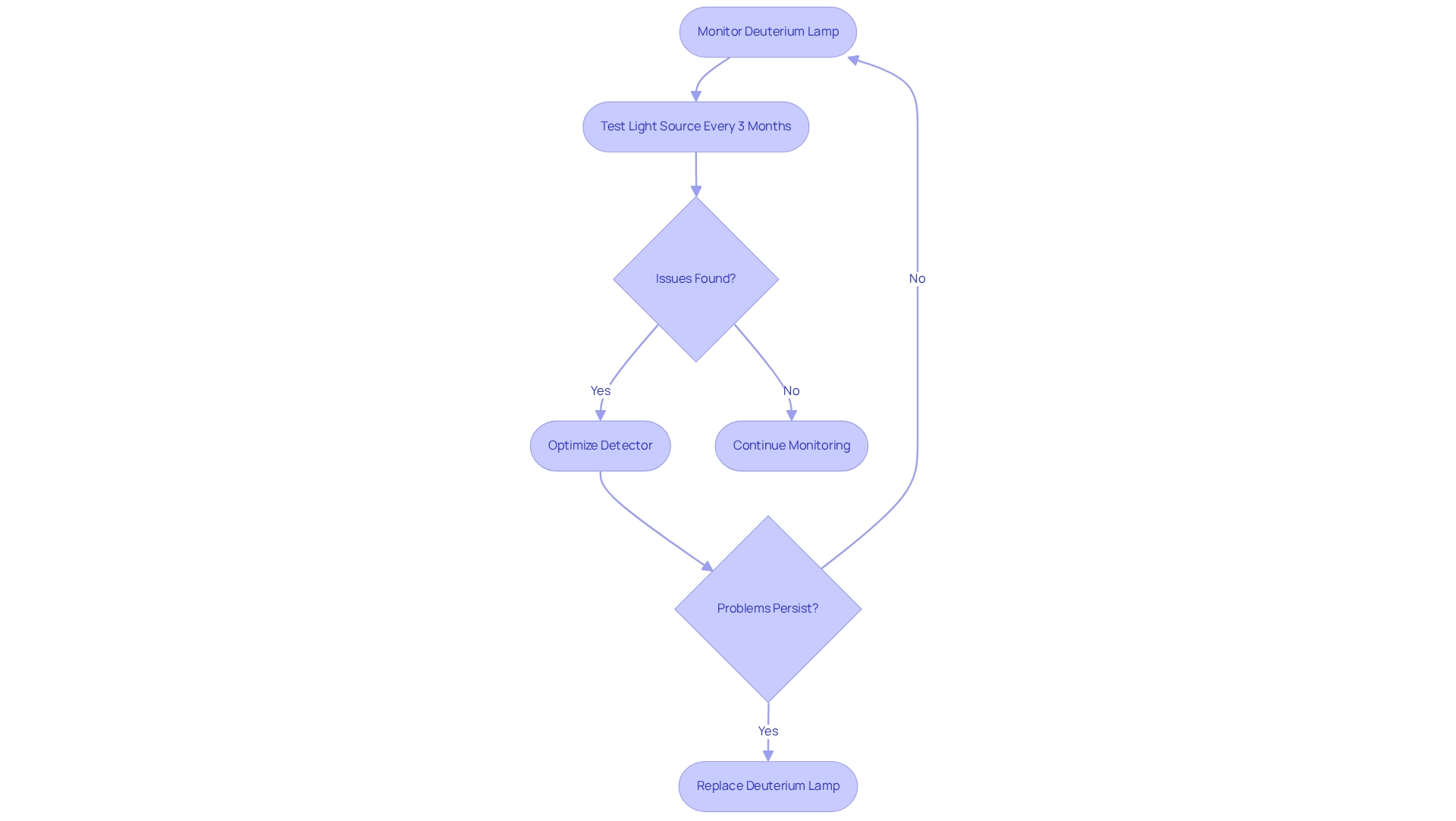
Spectral Irradiance Standards: Importance for Accurate Measurements
Spectral irradiance standards are essential for ensuring the accuracy and reproducibility of measurements obtained from UV-Visible spectroscopy. The deuterium lamp from JM Science is precisely engineered to meet rigorous standards, providing a consistent spectral output that conforms to established calibration protocols. This compliance is particularly crucial for facilities engaged in regulatory testing and research that demands high precision, such as pharmaceutical development.
As increasingly trends towards outsourcing calibration, adherence to these standards becomes even more critical. Sarah Moore notes that this shift is prompting a transformation in standard testing procedures within the pharmaceutical sector. By following these standards, facilities can enhance the reliability of their analytical results, ultimately supporting the integrity of their testing processes and contributing to advancements in pharmaceutical research.
Furthermore, the significance of calibration is underscored by case studies, such as the temperature control in the International Space Station, illustrating the broader implications of calibration standards in critical applications. Additionally, services provided by companies like Darwin Chambers for integrating stability chambers into organizations highlight the practical application of calibration in laboratory practices.
Signal-to-Noise Ratio: Enhancing Accuracy with Deuterium Lamps
The signal-to-noise ratio (SNR) is an essential parameter in spectroscopic measurements, directly impacting the clarity and reliability of data. JM Science's deuterium lamp sources are engineered to deliver , which is vital for identifying low-concentration analytes. By effectively reducing background noise and amplifying signal strength, these devices significantly enhance the overall precision of analytical outcomes. This makes them particularly suitable for sensitive applications, such as trace analysis in environmental testing, where accuracy is paramount.
HPLC Applications: Utilizing Deuterium Lamps for Enhanced Analysis
Deuterium lamps are pivotal in high-performance liquid chromatography (HPLC), emitting a continuous spectrum of UV light essential for the detection of various compounds. Their ability to provide consistent and stable light sources, particularly the deuterium lamp, significantly enhances the accuracy of absorbance measurements, making them indispensable in laboratories focused on pharmaceutical analysis, quality control, and environmental monitoring.
As we approach 2025, the significance of the deuterium lamp in pharmaceutical analysis continues to grow, aiding in the precise detection of analytes. The dependability of these devices, particularly the deuterium lamp, is underscored by their extensive application in HPLC, where they bolster the effectiveness of automated and high-throughput sample preparation methods. This methodological evolution not only improves consistency but also streamlines laboratory workflows, illustrating the essential role of deuterium lamp sources in contemporary analytical practices.
Practical examples underscore the efficiency of hydrogen isotopes, particularly when utilizing a deuterium lamp in pharmaceutical analysis. Case studies reveal their application in UV-Vis spectroscopy, which serves critical functions across various fields, including pharmaceuticals and biochemistry. The wide range of applications for UV-Vis spectroscopy emphasizes the importance of specialized light sources in fostering scientific inquiry and ensuring precise measurements. Specific results from these studies demonstrate how the use of deuterium lamp and hydrogen isotopes have elevated detection thresholds and enhanced overall analytical capabilities in .
Pharmaceutical lab managers stress the necessity of reliable light sources, including a deuterium lamp, in analytical processes, stating that 'analytical chemistry is the science of measurement, and each measurement holds a story.' This perspective reflects the crucial role that deuterium lamps play in delivering precise results, which ultimately contributes to the integrity of pharmaceutical research and development. As the landscape of spectroscopy evolves, with new light sources such as high-intensity LEDs emerging, the future appears promising for hydrogen isotopes. Anticipated innovations in the use of the deuterium lamp are expected to further enhance their performance in HPLC applications, solidifying their status as essential tools in the analytical chemistry toolkit.
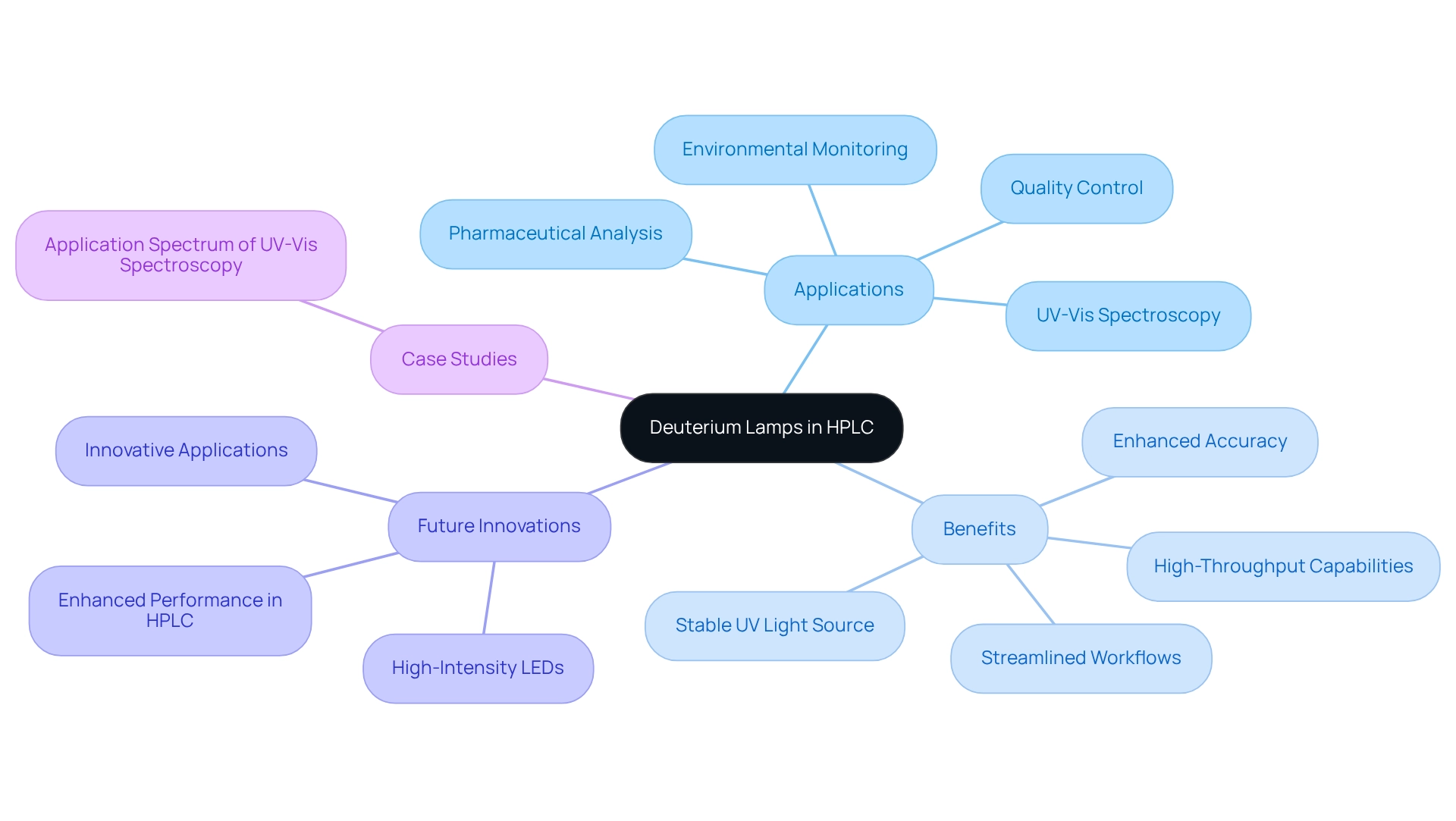
Spectrophotometer Compatibility: Ensuring Optimal Performance with Deuterium Lamps
The JM Science deuterium lamp is compatible with a wide array of spectrophotometers, particularly those from industry leaders such as Agilent and Thermo Fisher. This versatility allows facilities to [integrate deuterium lamps](https://blog.jmscience.com/10-essential-reagent-reservoirs-for-pharmaceutical-labs) into their existing systems with minimal adjustments required.
For instance, Juan M. from Columbia University has expressed his satisfaction with the incorporation of , which reinforces the reputation of reliable instruments in scientific environments.
To achieve optimal performance, users must adhere to proper alignment and calibration procedures. Consulting the spectrophotometer's manual for specific installation guidelines is highly recommended, as this will facilitate a smooth integration process and enhance overall laboratory efficiency.
Furthermore, obtaining between three and five readings for each standard is advisable to ensure accuracy and reliability in measurements, emphasizing the critical nature of meticulous installation and calibration practices.
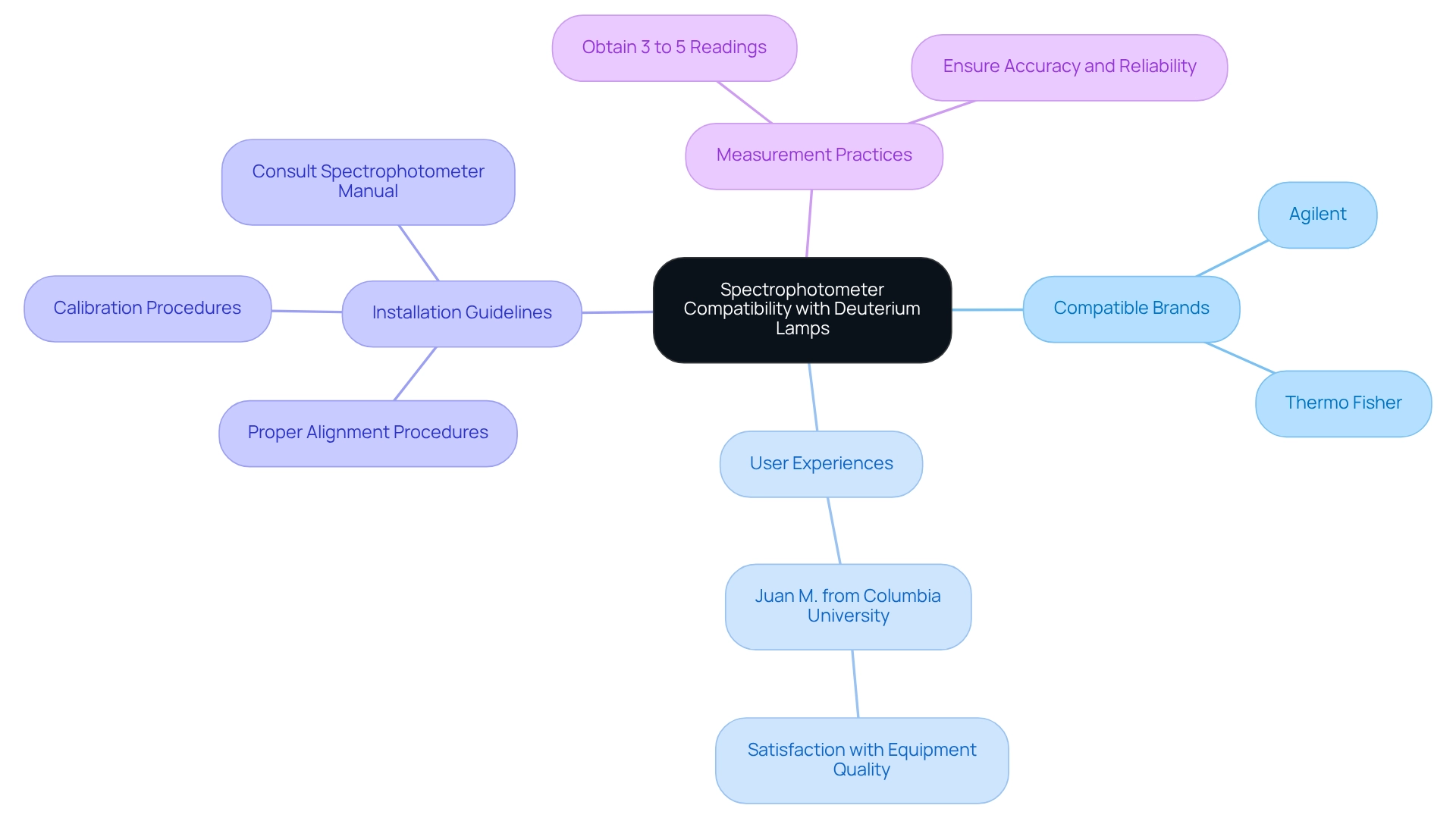
Maintenance Tips: Ensuring Longevity of Deuterium Lamps
To maximize the longevity of deuterium lamps, users should follow several key maintenance practices that ensure optimal performance and cost-effectiveness.
- Regular Alignment and Calibration is essential; consistently verifying the light source's alignment and calibration ensures optimal functionality. This practice not only maintains measurement accuracy but also prevents premature wear.
- Minimize On-Off Cycling to enhance durability. Frequent on-off cycling can significantly reduce the lifespan of the light. Instead, aim for consistent operation, which is vital for extending the operational life of these lamps.
- Maintain Cleanliness around the light source. Keeping the area tidy prevents dust buildup, which can disrupt functionality and lead to overheating. A clean environment is crucial for maintaining the integrity of the equipment.
- Monitor Output Intensity regularly. Evaluating the light source's output intensity and replacing it when it drops below acceptable levels can prevent unexpected failures, ensuring reliable results. This proactive approach is key to maintaining high performance.
Incorporating regular maintenance and documentation of lighting performance is crucial for making informed replacement decisions. As Mark Shapiro, director of analytical research & development at Cambrex, observes, "A large company may be less concerned about the cost of replacing a $600 light fixture every quarter, but a smaller one may choose to take the risk of replacing on a less frequent basis." By applying these optimal methods, research facilities can significantly increase the operational lifespan of deuterium lamps, potentially saving substantial expenses. For instance, performing each year for 25 devices could total nearly $100,000 annually. Prioritizing maintenance not only enhances analytical capabilities but also effectively manages operational expenses. Additionally, JM Science offers high-performance HPLC components and cutting-edge products that assist facilities in managing their gas discharge lights effectively.
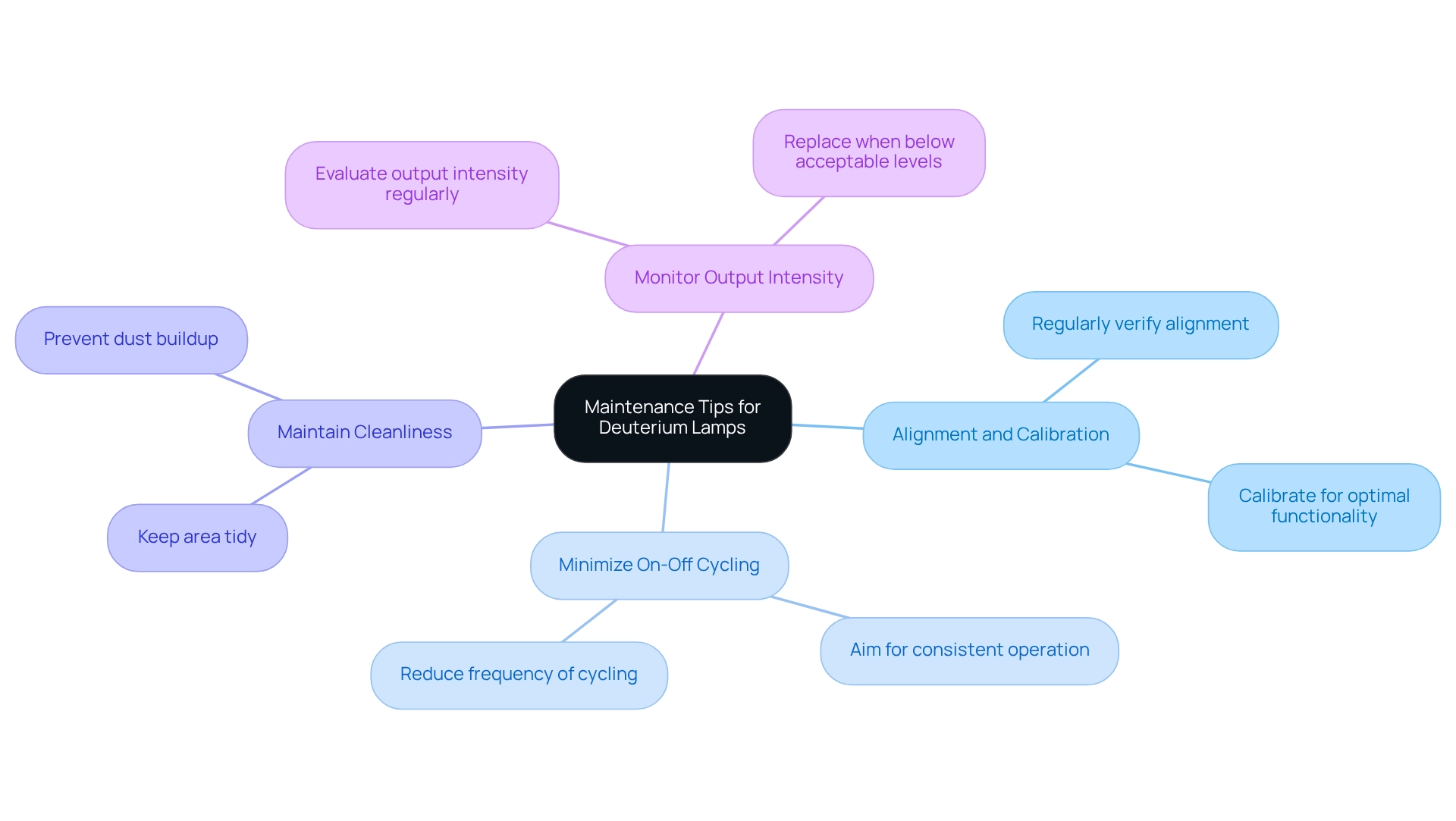
Cost Considerations: Budgeting for Deuterium Lamp Usage
When planning for the usage of the light source, laboratories must assess and continuous operational expenses. Although hydrogen isotopes typically require a greater initial expenditure compared to other lighting options, their longer lifespan and reliable performance can lead to reduced overall expenses over time. For example, the lifespan of a deuterium lamp often decreases the frequency of replacements, which can lessen long-term costs. Furthermore, it is essential to consider maintenance expenses and any possible downtime during light fixture replacements, as these elements can influence productivity in the lab. A strategic budgeting method not only assists facilities in maintaining high performance standards but also avoids unnecessary overspending, ultimately improving operational efficiency.
Practical instances demonstrate the cost-benefit advantages of these specialized lights. A recent case study highlighted how a facility upgraded its UltiMate™ 3000 Autosampler with Thermo Scientific™ upgrade kits, allowing for adaptable flow rates that improved analytical versatility. This improvement emphasizes the importance of investing in specialized lighting, as enhanced performance can result in substantial operational advantages. As facilities plan their budgets for 2025, it is essential to compare the initial and operational costs of deuterium lamps with those of other light sources. The Vision 7041, positioned as a new benchmark in UV/Vis spectrophotometry, exemplifies advancements in laboratory light sources that can influence budgeting decisions. This comparison will offer a clearer view of the long-term financial effects, allowing informed choices that align with both budgetary limitations and quality standards. For quick quotes and further assistance, potential customers are encouraged to contact JM Science.
Future Trends: Innovations in Deuterium Lamp Technology
The future of hydrogen light technology is set to undergo substantial advancements, particularly in energy efficiency and output stability. Innovations are emerging, including the integration of smart technology that facilitates real-time monitoring of lamp performance, enabling facilities to optimize their operations effectively.
Additionally, the development of hybrid light sources that fuse deuterium lamps with other technologies is anticipated to enhance versatility and expand application ranges. For example, recent market segmentation studies on indicate that comprehending specific user needs can significantly shape product development and marketing strategies.
As the market for UV light applications in the MEA region is projected to grow from 0.09 billion USD in 2023 to 0.16 billion USD by 2032, research facilities must stay informed on these trends to leverage new technologies that can enhance their analytical capabilities.
Industry leaders assert that adopting these innovations will not only elevate performance but also contribute to more sustainable laboratory practices.
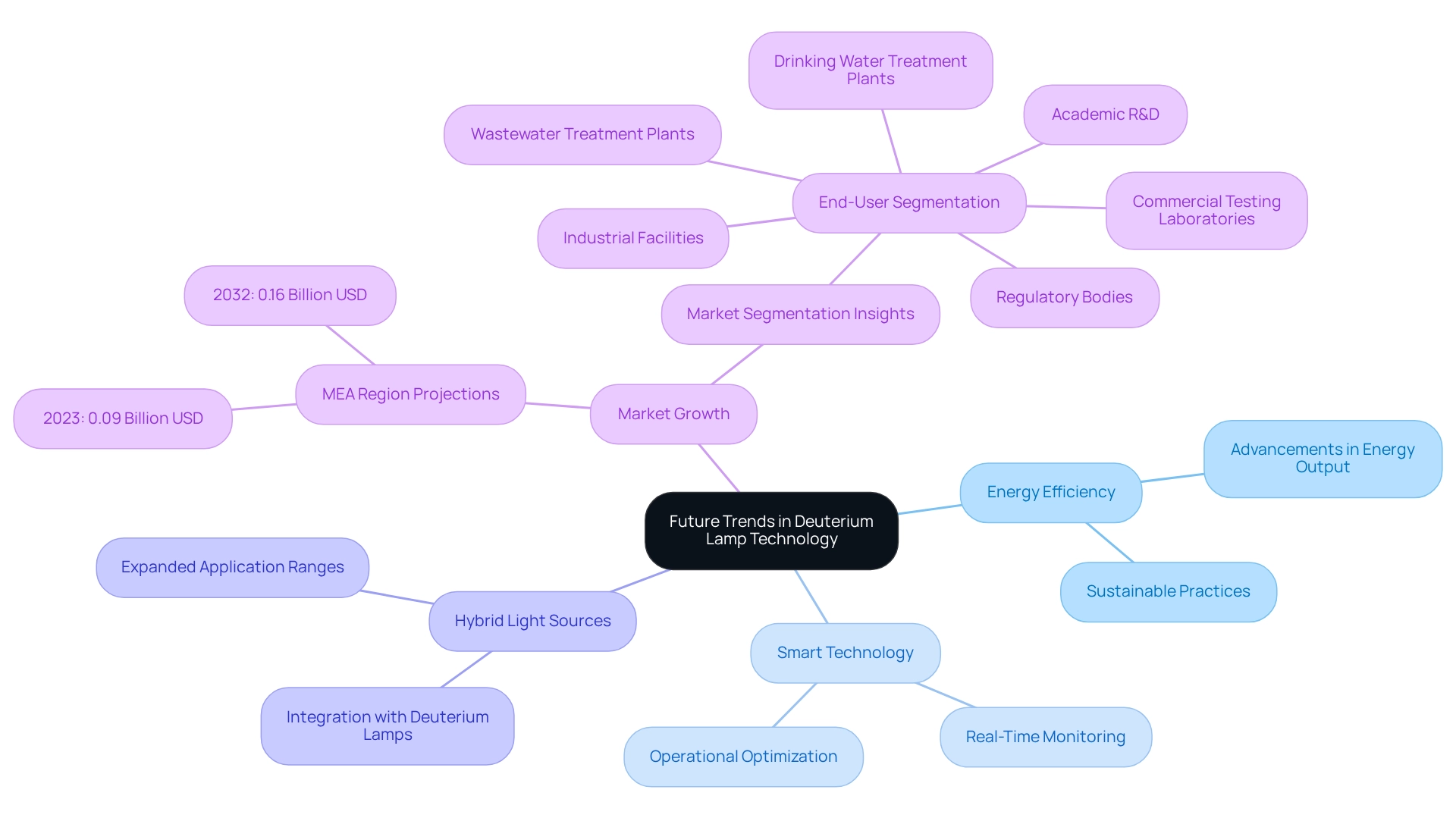
Conclusion
The JM Science deuterium lamp is a pivotal element in UV-Visible spectroscopy, serving as a dependable and stable light source critical for obtaining accurate and consistent spectral data. Its capacity to minimize output fluctuations is particularly essential in high-stakes environments such as pharmaceuticals and environmental monitoring, where precision is paramount. With advanced specifications and remarkable longevity, these lamps significantly enhance analytical accuracy across a variety of applications.
As laboratories increasingly integrate deuterium lamps for high-performance liquid chromatography (HPLC) and other analytical techniques, their compatibility with a broad spectrum of spectrophotometers further cements their status as indispensable instruments in contemporary scientific research. By adhering to proper maintenance practices and closely monitoring performance, laboratories can extend the lifespan of these lamps, thereby optimizing operational efficiency and reducing long-term costs.
Looking ahead, the future of deuterium lamp technology holds promise for exciting innovations, including improved energy efficiency and smart monitoring capabilities. As the demand for precise analytical measurements continues to escalate, remaining informed about these advancements will be crucial for laboratories striving to maintain their competitive edge. Ultimately, the JM Science deuterium lamp exemplifies the significance of reliable light sources in analytical chemistry and paves the way for future breakthroughs that will redefine the landscape of scientific research.




